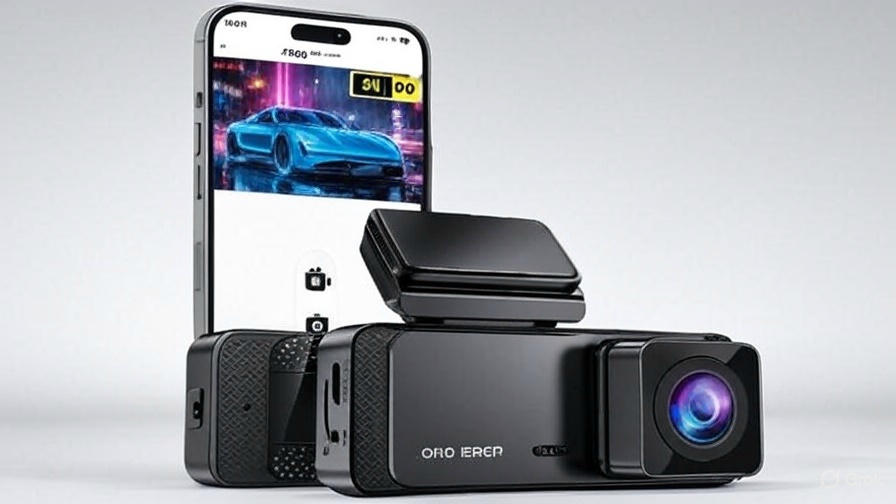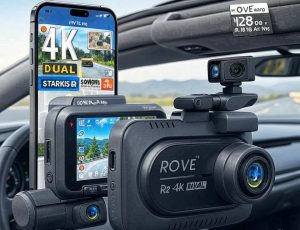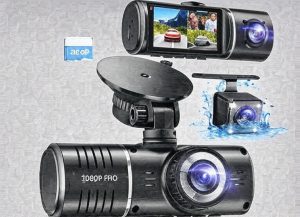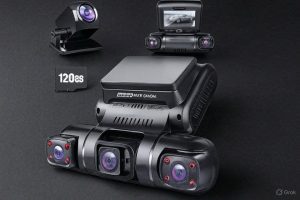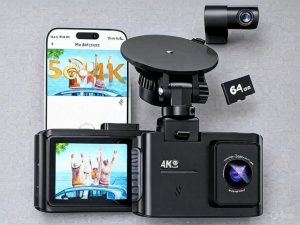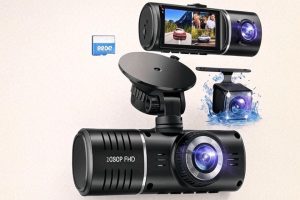Vehicle security has become a paramount concern for drivers worldwide. Road incidents, parking lot damages, and insurance fraud cases continue to rise, making dash cameras an essential investment for modern car owners. Finding the perfect balance between affordability and quality in dash cam technology can be challenging, especially with countless options flooding the market.
This comprehensive review examines five outstanding budget-friendly dash cameras that deliver exceptional value without breaking the bank. Each model offers unique features designed to meet different driving needs, from basic front recording to advanced triple-channel monitoring systems.
Contents
- Why Every Driver Needs a Reliable Dash Camera
- Top 5 Best Budget Dash Cameras: Detailed Analysis
- Essential Features to Consider When Choosing Budget Dash Cameras
- Installation Tips for Maximum Dash Camera Performance
- Maintenance and Care for Long-Term Reliability
- Cost-Effectiveness Analysis: Budget vs. Premium Options
- Legal Considerations and Privacy Guidelines
- Troubleshooting Common Dash Camera Issues
- Future Trends in Dash Camera Technology
- Conclusion: Making the Right Choice for Your Needs
Why Every Driver Needs a Reliable Dash Camera
Dashboard cameras serve as silent witnesses to everything happening on the road. These compact devices record continuous footage while you drive, providing crucial evidence in case of accidents, vandalism, or insurance disputes. The financial protection alone often justifies the investment, as dash cam footage can prevent fraudulent claims and establish fault in traffic incidents.
Insurance companies increasingly recognize the value of dash cam evidence. Many providers now offer discounts to drivers who install these devices, acknowledging their role in reducing claim disputes and processing times. The peace of mind that comes with knowing your journey is documented proves invaluable for both daily commuters and long-distance travelers.
Modern dash cameras offer features that extend far beyond basic recording. Night vision capabilities, parking mode monitoring, and smartphone connectivity transform these devices into comprehensive vehicle security systems. The technology has evolved to provide crystal-clear footage even in challenging lighting conditions, ensuring reliable documentation regardless of weather or time of day.
Top 5 Best Budget Dash Cameras: Detailed Analysis
1. V300 WiFi Dash Camera: Premium Features at an Affordable Price
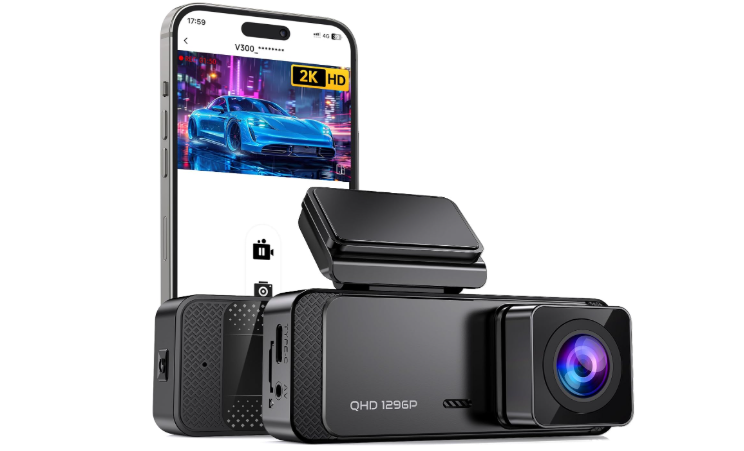
The V300 WiFi Dash Camera stands out as an exceptional front-facing recording solution that combines advanced technology with user-friendly operation. This compact device captures stunning 1296P resolution footage, delivering crystal-clear video quality that surpasses many competitors in its price range.
The WiFi connectivity feature sets this model apart from basic dash cameras. Users can easily connect their smartphones to view live footage, download recordings, and adjust camera settings without removing the SD card. This wireless capability proves particularly convenient when reviewing incidents or sharing footage with insurance companies.
Night vision technology ensures reliable recording during dark driving conditions. The camera’s advanced sensor and lens combination work together to capture clear footage even in low-light environments. Whether navigating dimly lit parking lots or driving through tunnels, the V300 maintains consistent video quality throughout various lighting scenarios.
The mini hidden design appeals to drivers who prefer discrete vehicle modifications. The compact form factor allows for easy installation behind the rearview mirror, maintaining an unobstructed view while providing comprehensive front-facing coverage. This subtle placement also reduces the likelihood of theft, as the camera remains virtually invisible to potential criminals.
Loop recording functionality automatically overwrites older footage when storage reaches capacity, ensuring continuous recording without manual intervention. This feature eliminates the need for regular memory card maintenance, allowing drivers to focus on the road while the camera handles file management automatically.
24-hour parking mode monitoring provides security even when the vehicle is unattended. The camera detects motion and impact events, automatically recording incidents that occur while parked. This feature proves invaluable for documenting hit-and-run accidents, vandalism, or attempted theft, providing crucial evidence for insurance claims and police reports.
Storage capacity support extends up to 256GB, accommodating weeks of driving footage before requiring overwrite. This generous storage allowance ensures important recordings remain available for extended periods, giving drivers ample time to review and save critical footage.
The V300’s smartphone app integration streamlines the user experience significantly. Drivers can preview recordings, adjust settings, and download important footage directly to their phones. This connectivity eliminates the need for computer transfers and enables immediate sharing with relevant parties when incidents occur.
Pros:
- Excellent 1296P video resolution
- Convenient WiFi smartphone connectivity
- Effective night vision capabilities
- Discrete hidden installation design
- Comprehensive 24-hour parking monitoring
- Large storage capacity support
Cons:
- Front-only recording coverage
- Requires stable WiFi connection for app features
- Battery life limited in parking mode
2. 3 Channel Triple Dash Camera: Complete Vehicle Coverage Solution
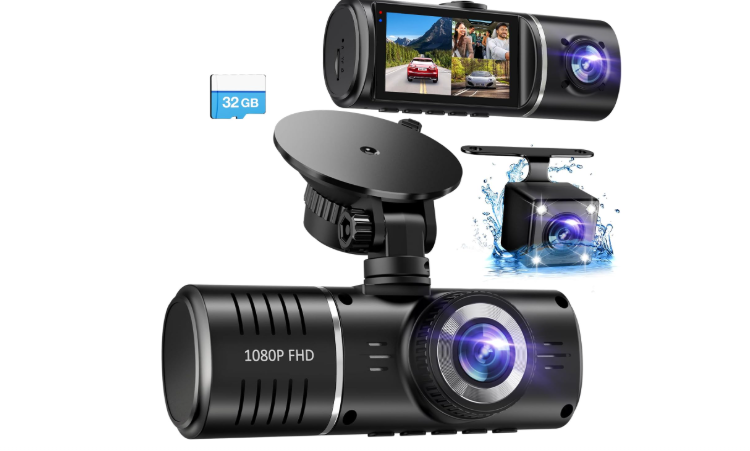
The 3 Channel Triple Dash Camera system revolutionizes vehicle monitoring by providing comprehensive coverage from multiple angles simultaneously. This advanced setup includes front, rear, and interior cameras, creating a complete recording ecosystem that captures every aspect of your driving experience.
Front camera recording delivers sharp 1080P footage of the road ahead, documenting traffic conditions, license plates, and potential hazards. The high-definition quality ensures clear identification of vehicles, pedestrians, and road signs, providing detailed evidence for accident reconstruction and insurance claims.
Rear camera monitoring proves essential for documenting incidents that occur behind your vehicle. Rear-end collisions, backing accidents, and parking lot incidents are thoroughly recorded, eliminating disputes about fault determination. The camera’s wide-angle lens captures a broad view of the area behind your vehicle, ensuring comprehensive coverage of potential blind spots.
Interior camera recording adds an extra layer of security for rideshare drivers, delivery personnel, and families with teenage drivers. The cabin-facing camera documents interactions with passengers, monitors driver behavior, and provides evidence in cases of passenger misconduct or false accusations.
The included 32GB memory card provides immediate recording capability right out of the box. While this storage capacity covers several hours of driving footage, users can upgrade to larger cards for extended recording periods. The included card ensures the system is ready for immediate use following installation.
HDR (High Dynamic Range) technology balances exposure across varying lighting conditions, producing clear footage regardless of environmental challenges. Whether driving from shaded areas into bright sunlight or navigating through tunnels, HDR processing maintains consistent video quality throughout changing light conditions.
G-Sensor impact detection automatically locks important footage when sudden acceleration, braking, or collision forces are detected. This feature prevents critical recordings from being overwritten during loop recording cycles, ensuring evidence of accidents remains permanently stored for future reference.
24-hour parking monitoring utilizes motion detection and impact sensors to record incidents while the vehicle is unattended. The system automatically activates when movement is detected near the vehicle, capturing potential vandalism, theft attempts, or hit-and-run incidents that occur in parking lots or driveways.
Loop recording management automatically overwrites older footage when storage capacity is reached, maintaining continuous recording without manual intervention. The system prioritizes locked files and recent recordings, ensuring important footage remains available while optimizing storage usage efficiently.
Installation complexity increases with triple camera systems, requiring careful planning and potentially professional installation for optimal results. However, the comprehensive coverage provided by this multi-camera setup justifies the additional installation effort for drivers seeking complete vehicle monitoring.
Pros:
- Complete triple-angle recording coverage
- Included memory card for immediate use
- Advanced HDR video processing
- Automatic impact detection and file protection
- Comprehensive parking mode monitoring
- Excellent value for multi-camera system
Cons:
- More complex installation requirements
- Higher power consumption than single cameras
- Limited individual camera resolution compared to dedicated units
3. 70mai M310 Smart Dash Camera: Intelligent Recording with Professional Features
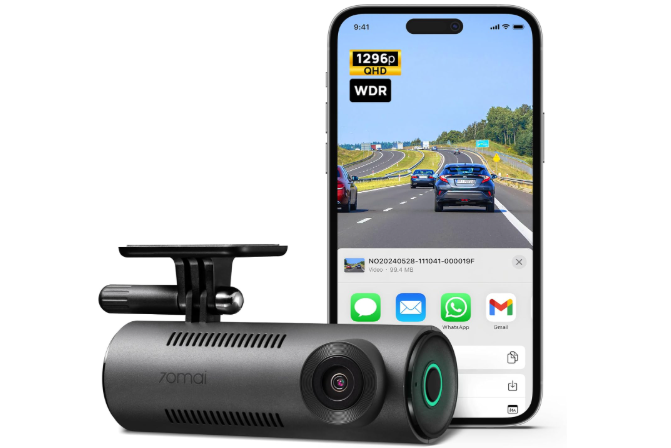
The 70mai M310 represents the cutting edge of smart dash camera technology, combining artificial intelligence with traditional recording capabilities to create an intelligent vehicle monitoring system. This camera delivers exceptional 1296P QHD video quality that rivals professional recording equipment while maintaining user-friendly operation.
Smart technology integration sets the M310 apart from conventional dash cameras. The device uses advanced algorithms to analyze driving patterns, detect unusual events, and optimize recording settings automatically. This intelligent approach reduces file sizes while maintaining critical footage quality, extending storage capacity and battery life significantly.
Built-in WiFi connectivity enables seamless smartphone integration through the dedicated iOS and Android mobile applications. Users can view live footage, download recordings, adjust settings, and receive notifications directly on their phones. This wireless connectivity eliminates the need for physical memory card removal and enables immediate footage sharing when necessary.
The 130-degree wide-angle field of view captures a broader perspective of the road ahead compared to standard dash cameras. This expanded coverage area documents more of the driving environment, including adjacent lanes, sidewalks, and potential hazards that might be missed by narrower-angle cameras.
WDR (Wide Dynamic Range) technology automatically adjusts exposure settings to handle challenging lighting conditions effectively. Whether driving into direct sunlight, emerging from dark tunnels, or navigating through rapidly changing light conditions, WDR processing ensures consistent video quality throughout various environmental scenarios.
Night vision capabilities utilize advanced low-light sensors and image processing to maintain clear recording quality during dark driving conditions. The camera’s ability to capture license plates, road signs, and vehicle details in low-light environments proves crucial for documenting nighttime incidents and ensuring 24-hour recording reliability.
Time-lapse recording mode compresses long periods of stationary footage into short, reviewable clips while maintaining motion detection sensitivity. This feature proves particularly useful during extended parking periods, reducing storage requirements while ensuring important events are captured and easily located for review.
Parking monitor functionality provides continuous vehicle security even when the engine is turned off. The camera detects motion and impact events, automatically recording incidents that occur while the vehicle is unattended. This feature requires hardwire installation for extended operation but provides comprehensive security coverage.
Loop recording automation manages storage efficiently by overwriting older footage when memory capacity is reached. The system prioritizes important recordings marked by G-sensor activation or manual button presses, ensuring critical evidence remains available while maintaining continuous recording capability.
The mobile app experience deserves special recognition for its intuitive design and comprehensive functionality. Users can easily navigate through recordings, adjust camera settings, and share footage directly from their smartphones. The app’s user-friendly interface makes dash camera management accessible to drivers of all technical skill levels.
Pros:
- Intelligent recording with AI optimization
- Excellent QHD 1296P video quality
- User-friendly mobile app integration
- Wide 130-degree viewing angle
- Advanced WDR technology
- Comprehensive time-lapse functionality
Cons:
- Premium pricing compared to basic models
- Requires hardwire installation for full parking mode functionality
- Mobile app dependency for advanced features
4. Miden S7 Dual Dash Camera: Superior Dual Coverage with Large Display
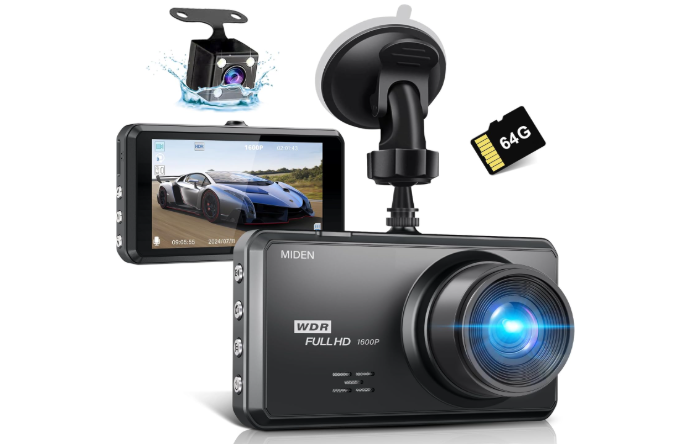
The Miden S7 dual dash camera system delivers exceptional front and rear recording coverage with premium features typically found in higher-priced professional systems. This comprehensive solution includes a generous 64GB SD card and offers outstanding 2.5K front recording resolution paired with 1080P rear camera quality.
The 1600P front camera resolution surpasses most competitors in the budget dash camera category, providing incredibly detailed footage that captures license plates, road signs, and vehicle details with remarkable clarity. This superior resolution proves invaluable for insurance claims, accident documentation, and general driving record keeping.
Rear camera recording at 1080P Full HD ensures comprehensive coverage of incidents occurring behind your vehicle. Rear-end collisions, parking lot accidents, and backing incidents are documented with clear, detailed footage that eliminates disputes about fault determination and provides crucial evidence for insurance claims.
Ultra-wide angle coverage combines 176-degree front viewing with 160-degree rear monitoring, creating an expansive field of view that captures more of the driving environment than standard cameras. This extensive coverage area documents adjacent lanes, sidewalks, and potential hazards that might be missed by cameras with narrower viewing angles.
The 3.2-inch IPS display screen provides convenient on-device footage review without requiring smartphone connectivity or computer access. This built-in display allows drivers to immediately review recordings, adjust camera settings, and verify proper operation directly on the device itself.
G-Sensor technology automatically detects sudden acceleration, braking, or collision forces, immediately locking important footage to prevent overwriting during loop recording cycles. This automatic protection ensures critical accident evidence remains permanently stored for insurance claims and legal proceedings.
WDR (Wide Dynamic Range) processing handles challenging lighting conditions by automatically adjusting exposure settings for optimal video quality. Whether transitioning between shaded and bright areas or driving through varying light conditions, WDR technology maintains consistent recording quality throughout different environmental scenarios.
Night vision capabilities utilize advanced sensors and image processing to capture clear footage during dark driving conditions. The system’s low-light performance ensures reliable documentation of nighttime incidents, license plates, and vehicle details even in dimly lit environments.
24-hour parking monitor functionality provides continuous vehicle security through motion detection and impact sensors. The camera automatically activates when movement or collision forces are detected, recording potential vandalism, theft attempts, or hit-and-run incidents that occur while the vehicle is unattended.
Loop recording automation manages storage efficiently by overwriting older footage when the 64GB memory card reaches capacity. The system prioritizes locked files and recent recordings, ensuring important footage remains available while maintaining continuous recording without manual intervention.
Installation considerations include proper placement of both front and rear cameras for optimal coverage. While the dual-camera setup requires more extensive installation than single units, the comprehensive coverage provided justifies the additional installation effort for drivers seeking complete vehicle monitoring.
Pros:
- Exceptional 2.5K front camera resolution
- Comprehensive dual-camera coverage
- Large 3.2-inch built-in display screen
- Ultra-wide angle viewing capabilities
- Generous 64GB included storage
- Advanced night vision technology
Cons:
- More complex dual-camera installation
- Higher power consumption than single cameras
- Larger physical footprint than compact single units
5. WiFi FHD 1080P Mini Dash Camera: Compact Excellence with Smart Features

The WiFi FHD 1080P Mini Dash Camera proves that exceptional performance can come in remarkably compact packages. This diminutive device delivers professional-grade recording capabilities while maintaining an incredibly discrete profile that appeals to drivers who prefer minimal dashboard modifications.
The miniature design allows for virtually invisible installation behind the rearview mirror, maintaining an unobstructed view while providing comprehensive front-facing recording coverage. This compact form factor also reduces the likelihood of theft, as the camera remains hidden from potential criminals viewing the vehicle from outside.
1080P Full HD recording quality captures sharp, detailed footage of road conditions, license plates, and traffic incidents. While not matching the ultra-high resolutions of premium models, this recording quality provides clear, usable footage for insurance claims, accident documentation, and general driving record keeping.
WiFi connectivity enables convenient smartphone integration through dedicated mobile applications available for both iOS and Android devices. Users can view live footage, download recordings, adjust camera settings, and share important clips directly from their phones without requiring physical memory card removal.
Night vision technology utilizes advanced low-light sensors to maintain recording quality during dark driving conditions. The camera’s ability to capture clear footage in dimly lit environments ensures reliable 24-hour documentation, providing crucial evidence for nighttime incidents and parking lot situations.
24-hour parking mode monitoring provides continuous vehicle security through motion detection and impact sensors. The camera automatically records when movement or collision forces are detected, documenting potential vandalism, theft attempts, or hit-and-run incidents that occur while the vehicle is parked and unattended.
WDR (Wide Dynamic Range) processing automatically adjusts exposure settings to handle challenging lighting conditions effectively. Whether driving from dark areas into bright sunlight or navigating through rapidly changing light environments, WDR technology maintains consistent video quality throughout various scenarios.
Loop recording functionality automatically manages storage by overwriting older footage when memory capacity is reached. This automation ensures continuous recording without manual intervention while prioritizing recent footage and files marked important by G-sensor activation or manual button presses.
G-Sensor impact detection automatically identifies sudden acceleration, braking, or collision forces, immediately protecting important footage from being overwritten during normal loop recording cycles. This feature ensures critical accident evidence remains permanently available for insurance claims and legal proceedings.
App integration provides intuitive control over camera functions and footage management. The smartphone application offers user-friendly navigation through recordings, easy sharing capabilities, and convenient adjustment of camera settings without requiring technical expertise or complex menu navigation.
Storage capacity support extends up to 128GB, providing ample space for extended recording periods before requiring overwrite. This generous storage allowance ensures important recordings remain available for review and ensures continuous coverage during long trips or extended parking periods.
Pros:
- Ultra-compact discrete design
- Reliable 1080P recording quality
- Convenient WiFi smartphone connectivity
- Effective night vision capabilities
- Comprehensive parking mode monitoring
- User-friendly mobile app integration
Cons:
- Single front-facing camera only
- Limited recording resolution compared to higher-end models
- WiFi dependency for advanced features
Essential Features to Consider When Choosing Budget Dash Cameras
Video resolution stands as the most critical factor when selecting any dash camera system. Higher resolution recordings provide clearer details for license plate identification, facial recognition, and accident reconstruction. While 1080P offers adequate quality for most situations, 1296P and 2.5K options provide superior detail that proves invaluable during insurance claims and legal proceedings.
Field of view determines how much of the driving environment gets captured in recordings. Wider angles document more of the surrounding area, including adjacent lanes and sidewalks, but can sometimes distort objects at the edges of the frame. Most quality dash cameras offer viewing angles between 120 and 180 degrees, with 140-160 degrees providing an optimal balance between coverage and image quality.
Night vision capabilities become crucial for drivers who frequently travel during dark hours or park in dimly lit areas. Advanced sensors and image processing technology enable modern dash cameras to capture clear footage even in challenging lighting conditions, ensuring reliable documentation regardless of environmental factors.
Storage management features like loop recording and automatic file protection prevent important footage from being accidentally overwritten. G-sensor activation should automatically lock critical recordings, while loop recording should efficiently manage available storage space without requiring manual intervention from the driver.
Parking mode functionality extends camera operation beyond active driving periods, providing security monitoring while the vehicle is unattended. Motion detection and impact sensors automatically trigger recording when incidents occur near parked vehicles, documenting vandalism, theft attempts, and hit-and-run accidents that might otherwise go unrecorded.
Connectivity options like WiFi and smartphone app integration streamline footage review and management processes. Wireless connectivity eliminates the need for physical memory card removal and enables immediate sharing of important recordings with insurance companies, police departments, or other relevant parties.
Build quality and durability ensure reliable operation under various environmental conditions. Dashboard cameras must withstand extreme temperatures, vibrations, and humidity while maintaining consistent performance. Quality construction and proper heat management prevent device failure during critical recording situations.
Installation Tips for Maximum Dash Camera Performance
Proper camera placement significantly impacts recording quality and legal compliance. The ideal location positions the camera behind the rearview mirror where it captures a clear view of the road while remaining discrete and avoiding obstruction of the driver’s vision. This placement also minimizes theft risk by keeping the device hidden from external view.
Power source selection affects both convenience and functionality. Cigarette lighter adapters provide easy installation but may not support parking mode features that require constant power. Hardwire installation enables advanced features like 24-hour monitoring but requires professional installation or electrical knowledge for safe implementation.
Memory card selection influences recording duration and reliability. High-endurance microSD cards designed specifically for dash cameras withstand the constant read/write cycles and temperature extremes associated with automotive use. Regular computer-grade cards may fail prematurely under these demanding conditions.
Cable management prevents distraction and maintains a clean vehicle interior appearance. Proper routing of power and camera cables along headliners, door frames, and dashboard edges keeps wires hidden while ensuring secure connections that won’t become loose during vehicle operation.
Angle adjustment ensures optimal recording coverage without compromising image quality. The camera should be level and aimed to capture the road ahead while avoiding excessive sky or dashboard inclusion in the frame. Proper angling maximizes useful recording area while maintaining clear horizon lines.
Initial testing verifies proper operation and optimal settings before relying on the system for important documentation. Recording sample footage during various lighting conditions, checking playback quality, and testing smartphone connectivity ensures the system functions correctly when critical incidents occur.
Maintenance and Care for Long-Term Reliability
Regular memory card formatting prevents file corruption and maintains optimal recording performance. Monthly formatting using the camera’s built-in function or computer-based utilities removes fragmented files and ensures reliable storage operation throughout the card’s lifespan.
Lens cleaning maintains recording clarity by removing dust, fingerprints, and environmental debris that can compromise image quality. Using microfiber cloths and appropriate cleaning solutions prevents scratches while ensuring consistently clear footage throughout all weather conditions.
Temperature management protects internal components from heat damage during extreme weather conditions. Parking in shaded areas when possible and using sunshades reduces interior temperatures that can damage electronic components and affect recording quality or device lifespan.
Firmware updates provide access to improved features, bug fixes, and enhanced compatibility with new memory cards or smartphone applications. Regular checking for manufacturer updates ensures optimal performance and access to the latest recording enhancements and security improvements.
Power connection inspection prevents intermittent operation caused by loose connections or corroded contacts. Periodic checking of power adapters, fuses, and hardwire connections ensures reliable operation and prevents recording gaps during critical incidents.
Storage backup creates permanent copies of important recordings before they’re overwritten by loop recording functions. Regular downloading of significant footage to computers or cloud storage ensures crucial evidence remains available for extended periods beyond the camera’s storage capacity limitations.
Cost-Effectiveness Analysis: Budget vs. Premium Options
Budget dash cameras provide essential recording functionality at prices accessible to most drivers, typically ranging from $50 to $150 for quality single-camera systems. These affordable options deliver reliable basic features including loop recording, G-sensor activation, and adequate video quality for insurance documentation and accident evidence.
Premium features like ultra-high resolution recording, advanced night vision, and sophisticated smartphone integration command higher prices but offer superior performance and convenience. Drivers must evaluate whether these enhanced capabilities justify the additional cost based on their specific driving needs and security requirements.
Installation costs vary significantly depending on chosen complexity and installation method. Simple cigarette lighter installations require no additional expense, while professional hardwire installation for parking mode functionality may add $100-200 to the total system cost but enables advanced security features.
Long-term value consideration includes potential insurance savings, accident claim protection, and theft deterrence benefits. Many insurance companies offer discounts for dash camera installation, and the devices can prevent costly fraudulent claims or establish fault in accident situations, potentially saving thousands in legal fees and increased premiums.
Feature prioritization helps determine optimal spending allocation between basic functionality and advanced capabilities. Drivers who primarily need accident documentation may find budget options sufficient, while those requiring comprehensive security monitoring benefit from investing in dual-camera systems with parking mode capabilities.
Return on investment calculations should include both direct financial benefits and peace of mind value. While quantifying security benefits proves difficult, the protection against false accusations, hit-and-run incidents, and vandalism often justifies the investment through prevented losses and reduced stress.
Legal Considerations and Privacy Guidelines
Recording legality varies by jurisdiction, with most areas permitting dash camera use on public roads while restricting audio recording in some locations. Drivers should research local laws regarding video recording, audio capture, and privacy expectations to ensure compliance with applicable regulations.
Privacy considerations include avoiding recording of private property, pedestrians on sidewalks, and interior cabin footage when passengers are present. Many jurisdictions require disclosure when recording audio or interior vehicle areas, particularly for commercial drivers or rideshare operators.
Evidence admissibility in legal proceedings depends on proper installation, continuous operation, and unedited footage presentation. Courts generally accept dash camera evidence when properly authenticated and relevant to case facts, making these devices valuable tools for accident reconstruction and fault determination.
Data protection responsibilities include securing recorded footage from unauthorized access and properly disposing of sensitive recordings when no longer needed. Drivers should implement password protection for smartphone apps and regularly delete routine footage while preserving important incident recordings.
Insurance notification requirements vary by provider, with some companies requiring disclosure of dash camera installation while others offer discounts for voluntary installation. Contacting insurance providers about dash camera policies ensures compliance and potential premium reductions.
Commercial use regulations often impose additional requirements for professional drivers, delivery personnel, and rideshare operators. These regulations may mandate specific recording capabilities, data retention periods, and passenger notification procedures that exceed personal use requirements.
Troubleshooting Common Dash Camera Issues
Recording quality problems often stem from dirty lenses, incorrect settings, or inadequate lighting conditions. Regular lens cleaning, proper exposure adjustment, and understanding camera limitations in various lighting scenarios resolve most image quality concerns.
Memory card errors typically result from using incompatible or low-quality storage media, insufficient formatting, or exceeding recommended capacity limits. Using high-endurance cards specifically designed for dash cameras and regular formatting prevents most storage-related issues.
Power supply problems manifest as intermittent operation, unexpected shutdowns, or failure to activate parking mode features. Checking fuse ratings, connection security, and power adapter compatibility resolves most electrical issues without requiring professional intervention.
Connectivity issues with smartphone apps usually involve WiFi signal strength, app version compatibility, or incorrect network passwords. Ensuring close proximity during connection attempts and keeping apps updated resolves most wireless communication problems.
Overheating concerns occur primarily during extreme summer conditions or inadequate ventilation around the camera housing. Proper installation positioning away from direct sunlight and ensuring adequate airflow prevents heat-related performance degradation or component failure.
Time and date accuracy problems affect footage organization and legal admissibility. Regular GPS synchronization or manual time setting ensures accurate timestamps that prove crucial for incident documentation and insurance claim processing.
Future Trends in Dash Camera Technology
Artificial intelligence integration promises advanced features like automatic incident detection, driver behavior analysis, and predictive safety warnings. These smart capabilities will transform dash cameras from passive recording devices into active safety systems that help prevent accidents before they occur.
Cloud storage connectivity will enable automatic footage backup, remote monitoring capabilities, and seamless integration with insurance companies and emergency services. This connectivity reduces reliance on physical storage media while providing enhanced security and accessibility for important recordings.
Higher resolution standards continue evolving toward 4K and beyond, providing unprecedented detail for license plate recognition, facial identification, and accident reconstruction. Improved sensors and processing capabilities make these ultra-high resolutions accessible at budget-friendly price points.
Integration with vehicle systems promises seamless operation through dashboard displays, steering wheel controls, and automatic activation based on driving conditions. This integration will make dash cameras as standard and intuitive as other vehicle safety systems.
Enhanced night vision technology using infrared illumination and advanced sensors will provide clear recording capabilities even in complete darkness. These improvements ensure reliable 24-hour documentation regardless of environmental lighting conditions.
Real-time streaming capabilities will enable live monitoring of vehicle locations and conditions, particularly valuable for fleet management, teenage driver supervision, and emergency response situations.
Conclusion: Making the Right Choice for Your Needs
Selecting the ideal budget dash camera requires careful consideration of individual driving needs, technical requirements, and budget constraints. Each of the five reviewed models offers unique advantages suited to different user preferences and driving scenarios.
The V300 WiFi Dash Camera excels for drivers seeking premium single-camera functionality with convenient smartphone integration and discrete installation. Its 1296P resolution and comprehensive parking mode make it ideal for daily commuters who prioritize quality and convenience.
The 3 Channel Triple Dash Camera provides unmatched coverage for drivers requiring comprehensive vehicle monitoring, particularly rideshare operators, delivery drivers, or those frequently driving in high-risk areas. The multi-angle recording capability justifies the additional installation complexity.
The 70mai M310 Smart Dash Camera appeals to technology enthusiasts who appreciate intelligent features and superior build quality. Its smart recording capabilities and professional-grade performance make it worth the premium pricing for discerning users.
The Miden S7 Dual Dash Camera offers exceptional value for drivers wanting front and rear coverage with premium features like 2.5K recording and a built-in display screen. The comprehensive package with included storage makes it an excellent choice for first-time dash camera buyers.
The WiFi FHD 1080P Mini Dash Camera provides essential functionality in an ultra-compact package, perfect for drivers who prioritize discrete installation and basic recording capabilities without advanced features or complex installation requirements.
Consider your specific driving patterns, security concerns, and technical comfort level when making the final selection. Each camera reviewed offers excellent value within its intended market segment, ensuring reliable performance and peace of mind regardless of your choice.
Remember that any dash camera is better than no protection at all. These affordable options provide crucial documentation capabilities that can save thousands in insurance claims, legal fees, and personal security concerns. The investment in reliable dash camera technology pays dividends through enhanced safety, security, and peace of mind for years of driving ahead.
